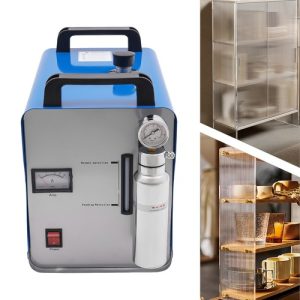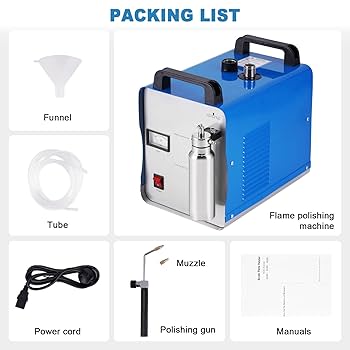Building your personal hydrogen oxygen generator at home may be an exciting and profitable project. Not only does it provide a deeper expertise of the electrolysis procedure, however it additionally lets in you to generate your very own hydrogen and oxygen gases. These gases can be used in a number of programs, consisting of HHO generator welding, oxyhydrogen torch cutting, and hho carbon cleaning. In this guide, we’ll walk you through the system of making your personal generator at the same time as retaining protection in thoughts.
A hydrogen oxygen generator uses the method of electrolysis to cut up water (H2O) into hydrogen (H2) and oxygen (O2). The generator runs an electric current through the water, breaking the water molecules into their constituent gases. The hydrogen produced can then be stored and used in various programs like welding, brazing, or powering an oxyhydrogen torch for slicing steel. Oxygen, on the other hand, can be used for similar functions or other industrial programs that require a clean and efficient oxygen delivery.
This method is the identical one utilized in larger-scale hydrogen gas manufacturing but scaled down for home or small workshop use. The simplicity of this method makes it ideal for DIY enthusiasts looking to construct their personal hydrogen oxygen generator.
Building your own hydrogen oxygen generator comes with a number of advantages. First and foremost, it offers you the possibility to study the system of hydrogen and oxygen manufacturing. For hobbyists and professionals concerned in welding or brazing, having a DIY generator can shop prices and provide the convenience of having a constant, on-call for supply of hydrogen and oxygen.
Creating your own generator additionally allows you to personalize it to suit your particular wishes. Whether you use it for small-scale hydrogen welding, cutting with an oxyhydrogen torch, or exploring different packages, constructing your very own gadget guarantees you have got manage over the great and output of the gases.
To construct a hydrogen oxygen generator, you’ll need a few vital additives. The most critical element is an electrolyzer—a tool that uses electrical present day to cut up water molecules. You’ll want a field to maintain the water, normally manufactured from a non-reactive material like stainless steel or plastic. The water is blended with an electrolyte answer (like potassium hydroxide or sodium hydroxide) to improve conductivity.
Next, you will need electrodes to skip the electrical present day through the water. Stainless steel or graphite electrodes are normally used in DIY hydrogen turbines. The power supply is another vital issue, as the electrolysis technique calls for a big quantity of electrical electricity. A 12V DC power supply is regularly ok for small DIY initiatives.
Finally, you’ll want tubing or hoses for accumulating and accurately transporting the gases produced (hydrogen and oxygen) and storing them in secure boxes. Safety is paramount whilst constructing and running the generator, so ensure to apply the right protection system, inclusive of flame arrestors and strain alleviation valves.

Building your DIY hydrogen oxygen generator starts with assembling your electrolyzer gadget. Begin by preparing your box to keep the water. Once that is done, insert the electrodes into the container, making sure they’re located well to maximize performance. The electrodes have to be linked to the electricity supply, and the electrolyte solution needs to be brought to enhance the conductivity of the water.
When putting in place the electricity delivery, ensure to use a regulated contemporary that is suitable for the dimensions of your task. Too many modern-day people may want to cause overheating or inefficient gas production. After connecting the gadget and turning on the power, you must start to see hydrogen and oxygen gases forming at the electrodes. These gases will want to be competently accumulated and stored in separate containers.
As you nice-track your DIY generator, you can regulate the voltage and electrolyte awareness to boom fuel output. Be sure to reveal the generator carefully to ensure it operates correctly and successfully.

Safety is essential while building and operating a hydrogen oxygen generator. Hydrogen fuel is exceptionally flammable, so it’s vital to have the right safety measures in location. Always paintings in a well-ventilated region to keep away from the buildup of hydrogen, which can shape explosive combinations with air. Use flame arrestors, which save you the ignition of hydrogen fuel, and make sure that your generator is properly sealed to avoid any leaks.
Additionally, make sure the fuel garage packing containers are designed to safely shop hydrogen and oxygen underneath stress. If using the gases for packages such as HHO welding or hydrogen torch brazing, ensure that you are following proper managing approaches. It’s additionally smart to have a hearth extinguisher and safety goggles handy while working with flammable gases.
To get the maximum from your DIY hydrogen oxygen generator, there are a few matters you could do to optimize its efficiency. First, ensure the electrodes you’re using are easy and well-maintained. Dirty or corroded electrodes can lessen the effectiveness of the electrolysis process and decrease hydrogen output.
Another manner to optimize performance is by means of experimenting with the electrolyte attention. The right stability of electrolyte can greatly improve the rate and quantity of gas produced. Higher concentrations of electrolyte commonly increase conductivity, which can cause better outcomes.
Lastly, adjusting the voltage of the energy supply can impact the performance of the electrolysis. Too low a voltage can also bring about inadequate hydrogen manufacturing, while too high a voltage can cause excess heat generation and electricity waste. Experimenting with specific settings will assist you discover the appropriate stability to your particular generator.
If your DIY oxy-hydrogen generator isn’t generating the favored quantity of gas, there might be numerous reasons. One common difficulty is poor electrode overall performance. Ensure that your electrodes are smooth and loose from corrosion, as this can notably affect gas production. If the electrodes are too far aside, the electrolysis system could be much less efficient.
Another trouble might be an inadequate strength delivery. Make sure your electricity supply is strong enough to address the burden required on your generator. Low voltage or present day can restrict the electrolysis method.
Finally, check the electrolyte answer. If the attention is simply too low, the machine won’t conduct enough energy to supply hydrogen correctly. On the other hand, too high an attention ought to lead to immoderate warmth and dangerous situations.
Hydrogen and oxygen gases need to be stored and transported with extreme care. Both gases are noticeably flammable, so right containment is essential to keep away from risky accidents. Use licensed pressure-rated bins for storing hydrogen, and ensure that the oxygen is stored in separate, well-ventilated cylinders.
When transporting the gases, ensure to comply with protection tips, consisting of retaining the packing containers upright and securing them to prevent movement. Always have a flame arrestor set up inside the tubing to save you the ignition of hydrogen in the course of transportation.
The price of constructing your own hydrogen oxygen generator can range relying on the scale and substances used. Typically, a small DIY system can cost between $one hundred and $three hundred, which incorporates the electrolyzer, electrodes, power delivery, and storage bins. However, the value can increase in case you’re building a bigger-scale generator or purchasing specialised equipment for applications like HHO generator welding or oxyhydrogen torch reducing.
While the preliminary investment might appear high, over time, a DIY generator can save you cash in comparison to buying pre-made hydrogen structures. Plus, the knowledge gained from building and maintaining the generator may be valuable.
Regular upkeep is important to make certain your hydrogen oxygen generator keeps to perform efficiently. Check the electrodes often for signs of damage or corrosion, as they are able to degrade through the years and affect overall performance. Clean the electrodes with a non-corrosive technique to make certain right capability.
Monitor the electrolyte solution and replace it whilst necessary. Over time, the electrolyte can become diluted or contaminated, decreasing the efficiency of the electrolysis method. It’s additionally a great idea to test all of the seals and connections in your gadget to make sure there are no leaks.
There are many on-line resources, along with forums, motion pictures, and distinct publications, wherein you can discover tutorials on building and optimizing a hydrogen oxygen generator. Websites committed to DIY projects regularly offer step-by-means-of-step instructions, troubleshooting guidelines, and advice on sourcing materials. You also can discover books and scientific papers on electrolysis and hydrogen technology that may offer treasured insights.
In conclusion, building a DIY hydrogen oxygen generator may be a satisfying and realistic task, specifically for the ones inquisitive about hydrogen-primarily based packages like HHO welding, oxyhydrogen torch slicing, or maybe renewable energy initiatives. With the proper materials, protection precautions, and a bit of trial and error, you can create a reliable gadget that serves your needs for future years.